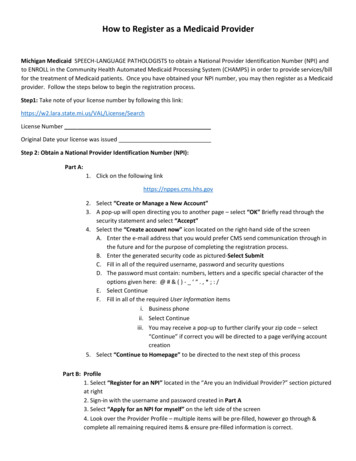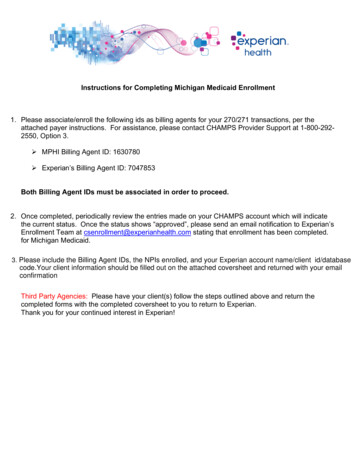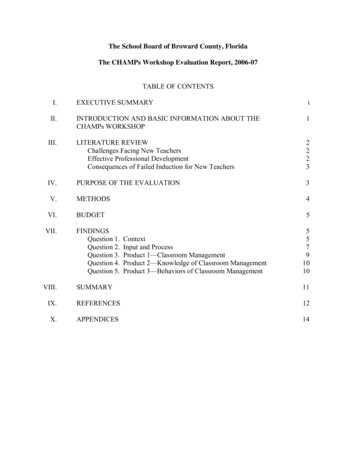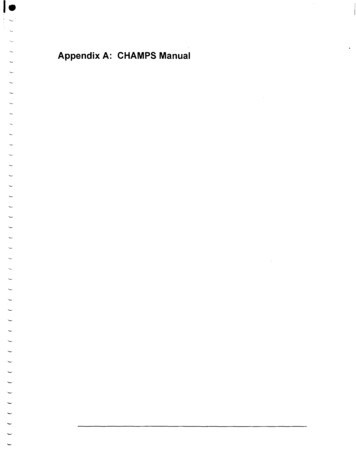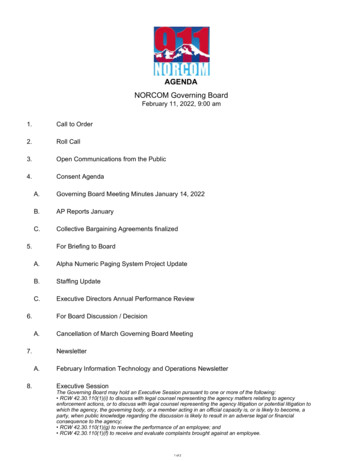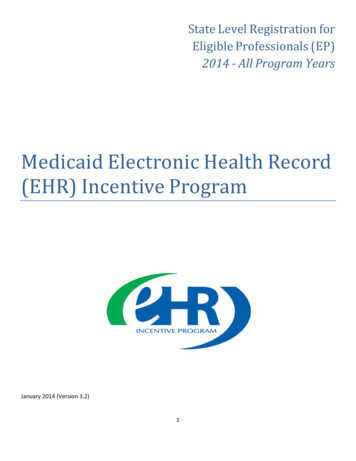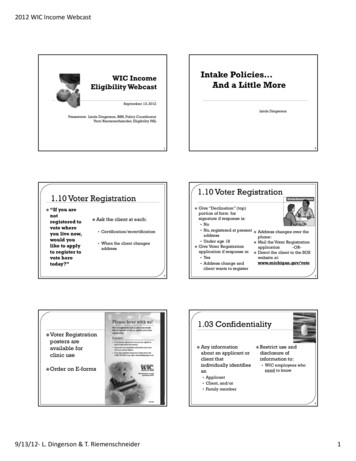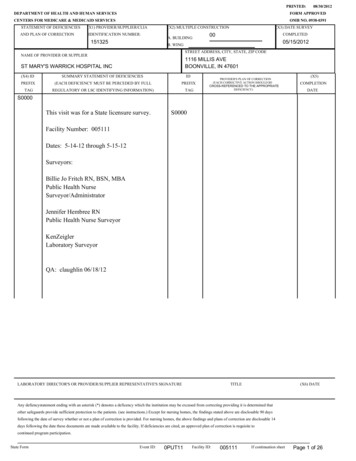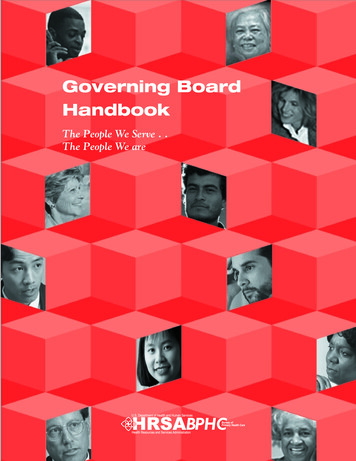
Transcription
Governing BoardHandbookThe People We Serve . .The People We are
Suggested CitationU.S. Department of Health and Human Services, Health Resources and Services Administration, Bureau ofPrimary Health Care, Bethesda, Maryland. Governing Board Handbook. 2000.This document was developed and produced by Circle solutions, Inc. under contracts No. 213-92-0009 and No. 240-94-0044 to the Bureau ofPrimary Health care, Health Resources and Services Administration, Public Health Service, U.S. Department of Health and Human Services. Judy A.Cramer and Cathie O’Donnell, coauthors; and Debbie Anchor, Lindi Copeland, and Debbara Micale, desktop publishers.
TABLEOFCONTENTSIntroduction . vModule 1. Building an Effective Board . 1Why Have a Board? . 1To Govern . 1To Link with the Community . 2It’s Required . 2What is a Board Supposed to Do? . 31. Define and Preserve the Mission ofthe Organization . 4The Mission Statement . 4Understand, Commit to, and Clarify the Mission . 5A Word About Goals and Objectives . 52. Make Policy. 6Consistent with Mission? . 6Formulating Policy . 7Operations . 8Personnel . 8Finances . 9Provision of Services/Quality Assurance . 9Implementing Policy . 103. Safeguard the Assets of the Center . 11External Rules and Regulations . 11Articles of Incorporation and Bylaws . 11Center Finances . 12The Budget . 13The Audit . 14Danger Signs . 144. Select, Evaluate, and Support the CEO . 16Selecting the CEO . 16Evaluating the CEO . 17Supporting the CEO . 185. Monitor and EvaluateCenter and Board Performance . 19Evaluating the Center’s Performance . 19Evaluating the Board . 20i
6. Plan for the Long-RangeFuture of the Center . 23Strategic Planning Defined . 23Why Is Planning Important? . 24Getting the Commitment for Planning . 24Who Should Plan? . 25The Planning Process . 25Short-Term Planning . 29What Is the Job of aMember of a Health Center Board? . 31The Duty of Care . 33The Duty of Loyalty . 33The Duty of Obedience . 34Module 2. Come on Board! . 37Internal Relationships and Functions. 37Board Organization . 38Board Size—Are We Too Big or Too Small? . 39Board Eligibility—Who Can Become a Board Member? . 39Board Selection—What DeterminesHow We Choose Board Members? . 41Terms—How Long ShouldBoard Members Serve? . 44Officers of the Board—Who Are They and What Do They Do? . 46Selecting Board Officers . 46Board Operations . 49Committees . 49Committee Membership . 50Types of Committees . 50Committees Report to the Board . 51Committees Have No Power or Authority . 52Board Meetings—Where the Action Is! . 53Getting Ready . 53Following the Rules . 54Making Motions and Voting . 54 ii
The Board and the Outside World . 56The Community Connection . 57The Community of Users . 57Public Relations. 57Community Fundraising . 58The “Other Provider” Community . 58Relationships with Health Center Staff . 60Relationships with Health Center Funders . 61Funders and Their Rules. 61Educating/Informing Public Policymakers . 63External Advisors . 64AppendicesAppendix A: Resource List . 65Appendix B: History of the Health Center Model . 69Appendix C: Chronology of theCommunity Health Center Movement . 81iii
iv
INTRODUCTIONThe Governing Board Handbook has been prepared for the HealthResources and Services Administration’s Bureau of Primary HealthCare (BPHC)-supported health center governing board members.This handbook has been designed as an orientation tool to assistnew members to understand the structure and responsibilities of agoverning board. It also describes the characteristics of healthcenter governing boards that make them unique. We hope that newand experienced board members will find the Governing BoardHandbook a useful tool.This Handbook is organized into two modules. Module 1 explainsthe purpose and responsibilities of a governing board. It alsoexplains the three major duties of a member of a governing board.Module II is an overview of how board operations relate to theday-to-day functions of a health center.These materials can be used by members of any health centergoverning board, but the focus is the specific characteristics andissues that face federally supported health center governing boards.The generic terms health center or center have been chosen toinclude any BPHC-funded or -supported health center or healthcare program. Also, while these terms may be interchangeable, theadministrator or executive director will be referred to as the chiefexecutive officer.Training and technical assistance and consultation for governingboard members of BPHC-supported health centers is made avail able by BPHC through a variety of resources including State/regional primary care associations, national organizations, andFederal staff. The “Resources List” following Module 2 of thehandbook lists national, regional, and state-level associations andother resources that may help to address specific issues that con cern your health center.v
A “History of the Community Health Center Model” is included asan appendix to this Handbook. This appendix has been providedfor those who may be interested in additional background informa tion on the community health center movement in the UnitedStates.Our thanks to the Executive Director and board members of South ern Jersey Family Medical Centers, Inc. and John Troidl (trainer)for allowing us to observe first-hand one of the Centers’ governingboard training sessions; and Sheila Ray of Ray & Associates, whoprovided additional writing, review, and expertise. We also thankthe following individuals for serving on the advisory committee toprovide direction, review, and suggestions during the developmentof the Governing Board Handbook: Mickey Goodson, chair; JohnCafazza and Paula McLellan, members. vi
module 1.BUILDINGANEFFECTIVE BOARDBeing a board member is a serious responsibility. At times,board members may feel slightly overwhelmed. But how theboard goes about doing its business does not need to becomplicated—especially if the board, as a whole, and itsindividual members, understand their responsibilities and actbased on that understanding.BOARDS EXIST TO:Because the board as a whole has roles, responsibilities, andauthority that are unique and different from the roles, re sponsibilities, and authority of each individual member, wehave organized this module to make those differences clear.In the sections that follow, we will briefly discuss whyboards are necessary and then present an in-depth discussionof the functions of the nonprofit board, and finally, summa rize the roles and responsibilities that are required of eachboard member.WHY HAVEABOARD?Your health center (center) has a board to: “Govern” the center Serve as a link with the community Comply with State and Federal laws.TO GOVERNThe board “governs”—it provides leadership and guides the centerin doing what it was intended to do. This requires an understandingof the mission, ensuring (preserving and developing) programs and1 Govern Link with thecommunity
services to fulfill that mission. It also requires providing a vision—a direction for the organization. Thus, the board governs thepresent and plans for the future in a way that preserves themission of the center.TO LINKWITH THECOMMUNITYThe board also serves a dual role in linking the center and thecommunity. The first part of its linkage role is to serve as thevoice of the community, representing the community and itsneeds to the center. The center has been established to meet aspecific need—to provide primary care services to thecommunity’s medically underserved and vulnerable residents.The board’s job is to represent the community in assuring that thecenter maintains the appropriate management and staff necessaryto provide the scope of services needed for that particular com munity. The second part of the board’s linkage role requires theboard to promote the center and its mission to the community.IT’S REQUIREDAlthough the center is a nonprofit organization, it is still a busi ness. It has been incorporated and granted tax-exempt status bythe State and the Federal Government to fulfill a need. A non profit business has rules regarding how it is managed. One ofthose rules is that it must establish and maintain a board to makesure that the organization continues to operate and to do what itwas set up to do. 2
WHAT IS A BOARDSUPPOSED TO DO?How a board goes about governing and ensuring that theorganization serves the community involves a variety ofactivities. Some boards have responsibility for overseeingthe operation of large health center networks that provide afull range of medical, dental, nursing, social support ser vices, and training programs to an extensive and diversepopulation. The operation of these centers is quite complexand involves managing many clinical, administrative, andsupport staff as well as overseeing considerable assets.Because of the complexity of this type of business, indi vidual board members tend to be more distanced from thedaily operation of the health center.BASIC RESPONSIBILITIESOF A NONPROFIT BOARDDefine and Preservethe Mission of theOrganizationMake PolicySafeguard the Assets ofthe CenterSome boards, on the other hand, may govern a center thathas only one site, limited staff, and serves a smaller, morehomogeneous client population. Members of these boardsmay have a closer and more “hands on” knowledge of theoperation of the center.Select, Evaluate, andSupport the CEOBecause of these differences, these boards may vary in theirapproach to “governing.” But their basic responsibilities (orduties) remain the same. These responsibilities are presentedhere as a series of six elements that build on and supporteach other each other:Monitor and EvaluateCenter and BoardPerformancePlan for the LongRange Future of theCenter3
1DEFINE AND PRESERVE THEMISSION OF THE ORGANIZATIONThe mission ofMerced Family HealthCenters, Inc. is to improvethe health status of ourpatients by providingquality, managed primaryhealth care services topeople in the communitieswe serve regardless oflanguage, financial, orcultural barriers.Merced Family Health Centers, Inc.Merced, CAMEASURE ACTIVITIESAGAINST MISSIONSTATEMENTEveryone, including each boardmember, center staff, chief executive officer (CEO), and the community, should understand whythe center exists and what it hopesto accomplish. This is a cornerstone responsibility of theboard—to make sure that everyone associated with the centerunderstands exactly why thecenter is in existence, and why itis important to ensure that thecenter continues to operate. Inother words, what is the mission(business) of the center?The Mission StatementA written mission statement is a public declaration of the center’sguiding principles or values. It lets everyone know what the centerstands for, its purpose, and the community to be served.Is the boardaccomplishing themission? If not, why?The mission statement should: Explain why the center was established and whom it serves Depict the services provided Illustrate what makes the center special or different—whyclients should use its services Point to a clear direction for future center activities andpriorities and form the basis for future planning Be “flexible”—provide for changes in the community andthe overall health care marketplace Be widely distributed and/or visible to center board, staff,and clients Be simply worded, brief, and to the point.Is the CEOaccomplishing themission? If not, why? 4
The mission statement is the basis for all board responsibilitiesand activities. It serves as the “Gold Standard”—the measure bywhich the board constantly assesses how well it and the CEO aredoing their jobs.Understand, Commit to, and Clarify the MissionMEASURE THE MISSIONS TATEMENT AGAINSTNEEDS AND GOALSMost new members join a board of a health center that has been inoperation for a period of time. In these situations, the center willprobably already have a mission statement. It is still the board’sresponsibility, however, to understand and commit to that mission.The board should also periodically review the mission statementto ensure that its principles are being fulfilled and that it is stillappropriate and relevant.Are the needs/goals of theowners (i.e., the com munity) reflected in themission statement?If not, why?Should the missionstatement be revisedIf so, why?In other words, it is the board’s job to continually clarify (ordefine) the mission of the center. The board should alsounderstand that all corporate goals and objectives should be basedon or “flow out of” the mission statement. Because the health careenvironment is constantly changing, it is the board’s job to beattuned to those changes and to ensure that the health center’sgoals and objectives remain dynamic and sensitive to themarketplace in which it operates.A Word About Goals and ObjectivesACTIVITIES AND MISSION—There is nothing complicated or mysterious about goals andobjectives. Just as in sports, goals are the ends—where we wantto be or what ultimately we want to achieve—whether that goal isto win a marathon or to improve access to health services forunderserved and vulnerable populations. Objectives are the stepswe take to achieve those goals. For example, to finish and win amarathon, a runner must train to cover the distance within acertain period of time. The runner’s first step (i.e., objective) inDo current and proposedprograms and serviceshelp accomplish thecenter’s mission andpurpose?5
reaching that goal may be to finish a marathon within 4 hours after 6months of training. For a health center, the first step (objective) inreaching a program goal of improving access to maternal and childhealth services may be to obtain 300,000 in new funds for perinatalscreenings by January of the following year.In each case, the goals are long range, concisely worded, and basedon what the individual (in the first example) or the board (in thesecond example) wants to achieve. Again, think of goals as the“ends” in what needs to be accomplished, and objectives as the“means” in describing how the goals will be met. Goals are accom plished by specific objectives that are measurable, realistic, andconsider the resources available to the health center. To Summarize:It is the board’s job to ensure that themission statement is well crafted and relevant, and that its principlesare being fulfilled through realistic goals and objectives. If this hasbeen accomplished, then the board’s job of making policy will bemuch easier. 2MAKE POLICY OperationsAnother primary responsibility of the board is to make and monitorpolicy. Policies furnish a framework for future decision making—they determine a general course of action to follow in similar orrecurring situations. Policies should ensure uniformity and consis tency of action throughout the organization. Policies must be consis tent with the overall mission, goals, and objectives of the center,with each other, and with applicable laws and regulations. PersonnelManagementConsistent with Mission? Fiscal Management ClinicalManagement andQuality AssuranceBOARDS MAKEPOLICY ABOUT:Whenever it initiates or changes policy, or takes any kind of actionrelated to the center, the board should first review the missionstatement and ask: “Is this policy (or decision) in keeping with themission statement? If not, why?” 6
If the proposed policy or action is not in keeping with the statedmission, the board must then decide: “Is this policy or actionappropriate or valid?” If the board determines that the policy oraction is indeed necessary and appropriate, but outside the existingmission statement, then the mission statement should be amendedto reflect that change. Caution: Boardsshould not change mission statements tooreadily. It is often easier to change a mission statement than tochange policy, but not always appropriate.Formulating PolicyNEVERIt may be helpful to know why and when boards set policy: To initiate action to accomplish the center’s mission As a response to a changing need from within thecommunity As a response to a directive or policy change from afunding agency.Make financial andprogrammatic decisionsindependently of eachother!Boards must address policies dealing with finance and with pro grams. In setting policy, a good rule of thumb is: Never makefinancial and programmatic decisions independently of each other!This is often easier said than done, and boards often observe thatmost of their meetings seem to be spent dealing with issues offinance and fundraising.The board must constantly reassess and reorder its priorities;interpret and evaluate its policies; and modify, discard, or createnew policies to meet the changing needs of the community, of thehealth center, and of its funding sources.7
When governing boards of health centers formulate policy, thisaction typically falls within one of four categories: operations,personnel, finances, and provision of services/quality assurance.Operations“ABC HEALTH CENTER”Although “ABC Health Center” sees patients fivedays a week, the number of patients has increasedand clients have to wait several weeks for a routineappointment.BOARD MAKES POLICYThe board of “ABC” sets a policy that clients shouldhave to wait no longer than 72 hours for anonemergency appointment.CEO/STAFF IMPLEMENTSThe CEO and staff follow that policy by extendinghours of operation on certain weeknights andadding Saturday hours.The board is ultimately responsible for efficient,effective, and sound operation of the health center.For example, the board should establish policiesthat: Address the process of selection, review, anddismissal of the CEO Provide for an effective organizationalstructure Ensure the availability of equipment, facilities,and personnel necessary to achieve thecenter’s goals and objectives Determine the scope, location(s), and avail ability of center services Establish a process for handling and resolvingclient grievances Ensure that the center is operated in compli ance with applicable Federal, State, and locallaws and regulations.PersonnelThe board should establish broad personnel policiesthat will guide the CEO in developing a sound andrealistic personnel program that includes: Selection and dismissal procedures Employee compensation, including wage andsalary scales and benefit packages Position descriptions and classification Performance review and evaluationprocedures Employee grievance procedures Equal opportunity practices. 8
FinancesThe board should establish policies that ensure proper administra tion of funds and accurate recording of the center’s financialactivities. For example, the board should: Establish the center’s financial priorities Institute long-range financial planning Review and approve the center’s annual budget and annualaudit.The board should also ensure the establishment of: Internal control procedures Purchasing policies and standards Protocols for determining eligibility for services,including criteria for partial-payment schedules A billing and collection system that:– establishes charges based on locally prevailingcharges and the health center’s costs– adjusts or discounts charges based on a person’sability to pay and family size– bills and collects from users of services and thirdparty payers, such as Medicare and Medicaid,insurance companies, or managed care plans– incorporates procedures for aging accountsreceivable– includes procedures for writing off bad debts.Provision of Services/Quality AssuranceThe center’s board is obligated to make sure that the CEO and staffmake continuing efforts to maintain and improve the quality ofcare that the center provides. Thus, the board should ensure that: The CEO hires a competent, qualified Medical Directorwho will supervise other clinical staff Generally accepted principles of quality health care aredeveloped and followed An internal quality assurance program provides for theperiodic review of the center’s performance in meeting thehealth needs of the community.9
THE BOARD’S RESPONSIBIL ITY DOESN’T END WITHMAKING POLICY . ONCEFORMULATED, POLICYThe board’s responsibility doesn’t end with making policy. Onceformulated, policy implementation must be reviewed andapproved by the board.IMPLEMENTATION MUST BEREVIEWED AND APPROVEDBY THE BOARD.Implementing PolicyThe board is responsible for making sure that the center’s CEOimplements the approved policy—and when that policy isimplemented, the board’s job is to support the CEO and the staffin their efforts.For example, in response to a newly enacted law or regulation,the board sets (makes) a policy to ensure that the center con forms to the new regulation. The CEO and staff act on (imple ment) that policy by purchasing new equipment, adding acapital improvement, or developing new or revised proceduresfor the center’s operations. The board sustains (supports) thepolicy by approving funds for capital improvements, if required.The board has the job of making policy while the center’s CEOand staff have the job of implementing policy. However, it isimportant for the board to be ready to accept ideas for policychange based on program needs put forth by the staff throughthe CEO.Note: It is the CEO and the staff who have first-hand knowl edge of the daily operation of the center. In fact, it is not uncom mon for staff to recognize a particular service need within thecommunity—even before the community representatives on theboard are fully aware of such a need. 10
3SAFEGUARD THE ASSETSTHE CENTEROFThe center’s board is placed in a position of trust by the commu nity and funding sources to protect the center’s assets, ensurethat the center’s income is managed properly, and preserve thecenter’s mission. In other words, board has a fiduciary responsi bility for management of the center.FIDUCIARYA person who acts as atrustee. A person acts in afiduciary capacity whenthe business transacted orthe money or propertyhandled is not for thatperson’s own benefit butfor the benefit of another.External Rules and RegulationsThere are various “external” rules that must be followed becausethe center is a nonprofit business chartered by the State. Thereare also other external regulations that must be followed becausethe center is tax exempt and therefore must comply with IRSrules and regulations and most likely receives a combination ofFederal, State, and private funding, which carries numerouslegal requirements. As part of its fiduciary responsibility, theboard is required to understand and follow all of these rules andregulations.Articles of Incorporation and BylawsEvery nonprofit business, including a health center, also has“internal” rules and regulations regarding how the center and theboard conduct business. These organizational and legaldocuments—the articles of incorporation and bylaws, are theground rules that the board is required to follow when it governs(makes policy).The articles of incorporation (sometimes called the corporatecharter) usually contain a statement about why the center wasfounded, a list of the center’s legal powers and authority, andany limits on that power or authority. It is very important that theboard understand that once the articles are approved by theState, the center cannot undertake any activities that are de scribed in the articles of confederation.11
SAFEGUARDING FINANCESBylaws are detailed rules about how an organization will begoverned. They deal with procedure rather than with guidingprinciples. They generally include: How and when board meetings will be conducted How board members and officers will be selected Duties of corporate officers Committee structure Description of the board’s relationship with the center’sCEO and staff.(See Module 2 for a detailed discussion of these “internalrules and regulations.) Understand where themoney is coming fromCenter Finances Understand how themoney is being spent Understand how toplan for neededservices and growthAs part of its fiduciary responsibility to safeguard the center’sassets and resources, the board continually must address issuesof finance. The board should be clear about the ground rulesand its role in the financial management of the center. Theboard’s job is to: Make policies that clearly define– sources of revenue and categories of expendi tures in the budget– the process for adjusting to meet the actualfinancial situation as the year progresses Leave the details to management (as long as thosedecisions are within the boundaries set by boardpolicy) Monitor the status of income and expenditures againstthe policies made by the board regarding the annualbudget Compare the actual financial condition of the centeragainst the policies originally set by the board Plan for needed revenue sources and plan and budgetfor capital improvements.If the board operates within this framework—that is, the boardmakes policy and the CEO acts on that policy—the board’sability to govern will not become fragmented or disorganizedand its ability to protect center assets will be preserved. 12
The BudgetThe board must pay careful attention to the budget. The boardmust review and approve the annual budget (usually prepared bythe center’s CEO and staff). Approval of the annual budget is oneof the most significant policy decisions that the board will makeand it sets in motion a series of programmatic, personnel, andfiscal decisions.The board should think of the budget as the center’s businessplan—how it will spend the center’s revenues to pay for theservices that it provides—and it should regularly compare thereal state of finances (called actuals) to what was planned for inthe budget when it was first presented and approved (calledprojections). While the audit (see below) may fulfill a legalrequirement and help protect against financial mismanagement, itmay not reveal problems until a year after they happen.1 Abudget, if monitored regularly (monthly, if possible), will helpidentify problems as they occur.Because it is responsible for monitoring the center’s finances, agoal for any board should be to assure that at least one boardmember has financial expertise. It is also important to keep inmind that the board can only truly monitor budget performance ifit has understandable, accurate, and timely information. Theboard, therefore, has the right to receive monthly fiscal statusreports that include a comp
This handbook has been designed as an orientation tool to assist new members to understand the structure and responsibilities of a governing board. It also describes the characteristics of health center governing boards that make them unique. We hope that new and experienced board members will find the Governing Board Handbook a useful tool.
